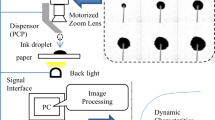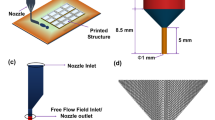Abstract
Diffuse painting, or ‘Nijimi’, which is the most remarkable feature of black ink painting (called ‘Sumie’ in Japanese), is produced by letting the ink diffuse into the absorbent paper. The diffusion of the ink usually results in a delicate blurred image. A model for simulating the nijimi effect with computers has been developed. It is based on the physical analysis of the construction of the paper, the characteristics of liquid flow and particle adsorption, and the interaction between the liquid and the paper. The images generated by this model are proved to fit well with the observed patterns.
Access this chapter
Tax calculation will be finalised at checkout
Purchases are for personal use only
Preview
Unable to display preview. Download preview PDF.
Similar content being viewed by others
References
Bruderlin A, Calvert TW (1989) Goal-Directed, Dynamic Animation of Human Walking. Computer Graphics 23(3):233–242
Fournier A (1986) A Simple Model of Ocean Waves. Computer Graphics 20(4):75–84
Greene R (1985) The Drawing Prism: A Versatile Graphic Input Device. Computer Graphics 19(3):103–117
Lewis JP (1984) Texture Synthesis for Digital Painting. Computer Graphics 18(3):245–252
Montroll EW, Lebowitz JL (1979) Studies in Statistical Mechanics-VII. North-Holland Publishing Company
Peachey DR (1986) Modeling Waves and Surf. Computer Graphics 20(4):65–74
Plass M, Stone M (1983) Curve-Fitting with Piecewise Parametric Cubics. Computer Graphics 17(3):229–238
Strassmann S (1986) Hairy Brushes. Computer Graphics 20(4):225–232
Thalmann D (1989) Motion Control: From Key-frame to Task-Level Animation. Proceedings of Computer Animation ′89, State-of-the-art in Computer Animation 1–17
van de Ven TGM (1989) Colloidal Hydrodynamics. Academic Press
Ziman JM (1979) Models of Disorder – The theoretical physics of homogeneously disordered systems. Cambridge University Press
Author information
Authors and Affiliations
Editor information
Editors and Affiliations
Rights and permissions
Copyright information
© 1991 IFIP International Federation for Information Processing, 16 place Longemalle, CH-1204 Geneva, Switzerland
About this chapter
Cite this chapter
Guo, Q., Kunii, T.L. (1991). Modeling the Diffuse Paintings of ‘Sumie’. In: Kunii, T.L. (eds) Modeling in Computer Graphics. IFIP Series on Computer Graphics. Springer, Tokyo. https://doi.org/10.1007/978-4-431-68147-2_21
Download citation
DOI: https://doi.org/10.1007/978-4-431-68147-2_21
Publisher Name: Springer, Tokyo
Print ISBN: 978-4-431-68149-6
Online ISBN: 978-4-431-68147-2
eBook Packages: Springer Book Archive




